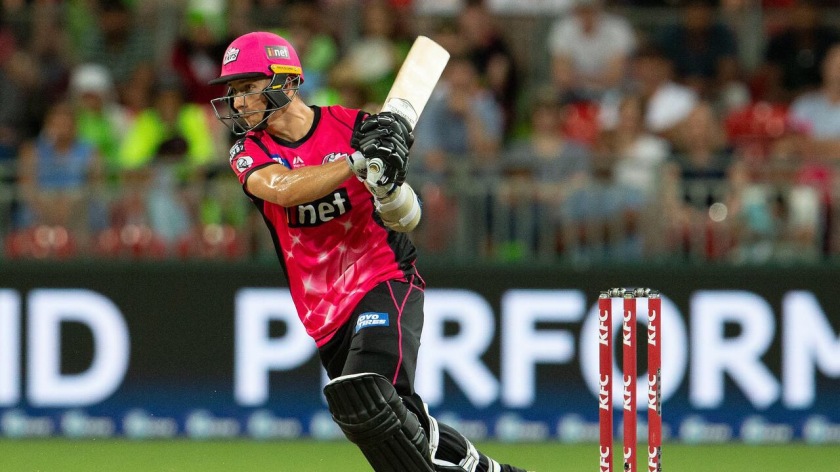The matches keep coming as we dive headfirst into the second round of the 2018-19 Big Bash League season. The tournament continues to be a source of entertainment over the Christmas holidays and provides a stark contrast against the Boxing Day Test in Melbourne.
It is at this point where we start to see which players are in red hot form and which are not at this early stage. With that in mind, here are just five new statistics we are using to evaluate each team’s 18 players:
1) Boundary Rate
Boundary Rate, or balls per boundary, gives us an indication of how often batsman are finding the fence. It allows us to separate monster boundary hitters, such as Chris Lynn, from those who are not regular boundary scorers.
Interestingly enough, as it stands Lynn ranks just 25th on our list of top boundary hitters this season. After struggling to find the rope often at Metricon Stadium, the powerful Queenslander is hitting a boundary every 6.3 balls.
The batsmen at the top of the list are not who you expect, but there is a reason for that. Afghanistan’s Rashid Khan seemingly can do no wrong with ball or bat and tops our boundary rate rankings scoring a boundary every 3 deliveries after hitting two fours and two sixes in Adelaide Strikers’s meagre 88 against Perth Scorchers.
Next on the list is Sydney Thunder fast bowler Daniel Sams with 4 and Brisbane Heat opener Max Bryant with 4.3. Englishman Jos Buttler sits fourth on the list of top run-scorers this season and it is clear from looking at his boundary rate of 4.4 that he is also scoring his runs rapidly. Following a 63 against the Sydney Sixers, Buttler will definitely be one to watch as the tournament progresses.

Englishman Jos Buttler is hitting a boundary every 4.4 balls this season // Herald Sun
2) Bowler Control Index
One of methods baseball analysts use to measure a pitcher’s ability is the power finesse ratio. The power finesse ratio estimates the number of times the pitcher rather than the batter influences the outcome of an at-bat. Therefore, the Bowler Control Index (BCI) calculates the percentage of bowler-controlled deliveries out of the total number of balls bowled.
It should come as no surprise then, that the bowler in control of the majority of their deliveries is Adelaide Strikers’ Rashid Khan (65.3%). What you may not have realised is that David Willey (60) ranks second highest followed by the always economical Peter Siddle (58.3). Stephen O’Keefe (52), Jason Behrendorff (51.4) and Billy Stanlake (50) round out the top six.
If these are the bowlers with the most control, then who are the bowlers with the least control? Interestingly, spin bowlers have less control. Part-timers Ashton Turner (0) and Glenn Maxwell (11.1) rank lowest followed by the Sydney Sixers’ Lloyd Pope (13.3). Ashton Agar and Michael Beer (both 16.7) complete the bottom five.
3) High and Low Conceding Overs
Another statistic being measured by us this season is the number of runs scored off each of the bowlers’ overs. Specifically, how many overs where less than three runs were scored, how many overs where more than six runs were scored and how many overs where more than ten runs were conceded. Used in conjunction with a bowler’s economy rate, this can be used to further analyse how successful a bowler has been at defending runs.
The bowlers with the most overs where less than three runs were scored are Rashid Khan and Jason Behrendorff (both 4). While Khan’s economy rate is better than Behrendorff (3.42 to Behrendorff’s 5.08), the fast bowler is the only player in the tournament to have bowled consecutive overs of less than three runs… Twice.
Stephen O’Keefe (3) also has an economy rate below six as has Jhye Richardson (2) after his incredible spell of 3 for 7 against Adelaide Strikers. Melbourne Renegades’ Jack Wildermuth (2) has bowled the most less than three run overs with an economy over 6.
On the flip side, Michael Neser (6), Tom Curran and Ben Cutting (both 5) have bowled the most overs where more than six runs were scored. Meanwhile, Billy Stanlake has conceded more than ten runs off an over on 6 occasions. That is half of Stanlake’s overs bowled in the tournament so far.
4) Team Wicket Percentage
An adage used in games and military combat states that “the best defence is a good offence”. This is especially true in the case of the bowlers in the Big Bash League. The ability for teams to take wickets and bowl opposition sides out is a crucial skill. It’s why the Perth Scorchers have been so dominant in the early years of the competition and it was a critical part of the Adelaide Strikers’ title-winning season last year.
At this point in the 2018-19 edition of the Big Bash League, the team that has done this most successfully is the Sydney Sixers. The Sixers have taken 85% of all available wickets this season at a strike rate of 14.2. Sydney Thunder have a better strike rate of just 11.2 but, have only taken 75% of available wickets. Hobart Hurricanes and Melbourne Renegades have also taken 75% of available wickets with strike rates over 15.
Whilst early days just yet, each team’s wicket percentage will become important as the tournament goes on when it becomes critical for teams to close out tight matches.

Sydney Sixers have taken 85% of all available wickets this season at a strike rate of 14.2 // AAP/Steve Christo
5) Net Contribution
Finally, net contribution is being used by us this season to measure a player’s defensive liabilities against offensive output. So far, this statistic has been used as an essential evaluation tool for wicketkeepers, especially in an age where pure glovemen are being cast aside in favour of specialist batsmen who can keep a bit. Net contribution is calculated on a match basis rather than an innings basis because there may be occasions where wicketkeepers don’t bat.
The most productive wicketkeeper so far has been Sydney Thunder’s Jos Buttler. With scores of 20 and 63 in his opening matches and no byes or dropped catches conceded, Buttler has contributed 41.5 runs per match to the Thunder. Alex Carey’s scores of 70, 5 and 11 with one run cost as the result of an overthrow puts him second with 28.3 runs contributed per match.
The worst offender with the gloves this season has been Matthew Wade of the Hobart Hurricanes. Wade’s half-century against the Melbourne Stars put him back into positive figures at least, but a dropped catch off Ben Cutting cost his side an extra 55 runs. This means that, Wade has contributed just 1 run per match.
Although this statistic is only being used to measure wicketkeepers at the moment, there is no reason why it can’t be applied to the other nine fielders. Melbourne Stars’ Nick Larkin has been impressive with the bat scoring 28 and 45 in his first two innings this season. However, Larkin has now dropped three catches this season costing the Stars a total of 71 runs. Just like Wade, Larkin has contributed just 1 run per match to his team.

Nick Larkin drops his third catch of the summer, this time against the Hobart Hurricanes.
